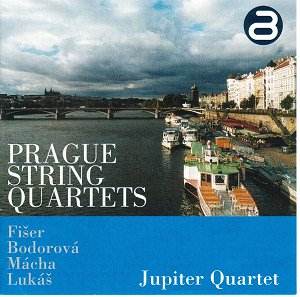Though some of the names on this disc were new to me, I
played this disc with some anticipation, given the rich heritage of
Czech chamber music this century, from Dvorak through Janácek, Martinu
and Haba. It is devoted to a group of four contemporary Prague-based
Czech composers calling themselves 'Quattro' and, as the title suggests,
features a selection of their works for that most demanding of genres,
the string quartet. The informative booklet note quotes their artistic
manifesto as a search for "the fundamental questions of life and the
meaning of artas something inconceivable without contact with the public
- it is the public to whom they endeavour to speak". Amen to that! And
it is a measure of their success in carrying out this aim that all the
featured works here inhabit a traditional soundworld that is
communicative and enjoyable without being over-demanding. This is not
meant to be disparaging; they all manage in their own individual ways to
effectively explore the sonorities of the medium without resorting to
the excesses and cheap gimmickry that too often distort the modern
quartet in an attempt to exorcise the ghost of Bartók.
Indeed it is true to say that the spirit of Bartók does
hover over many aspects of these compositions (as indeed does that of
Janácek ) but in a positive way. Elements of harmony (particularly the
folkloric modality that each takes as its starting point) and rhythm
constantly recall the Hungarian masters mature quartets; but the fact
that the role of melody appears crucial to each of these composers
immediately gives an individuality to their creative voice.
The disc starts with the relatively brief one-movement
work by Lubos Fiser (1935-1999), a native of Prague, who wrote his only
String Quartet in 1984, dedicating it to the Talich Quartet who
gave the first performance at the Prague Spring Festival in the same
year. It is a concentrated work, eschewing a traditional sonata type
structure in favour of blocks of material which are juxtaposed and developed
in various ways. Dissonance is employed (with the tritone becoming a
binding feature) but not in an aggressive manner. The ear is led on
a journey which feels entirely logical and satisfying, with Fisers material
containing memorable melodic motives that return in transformed states,
the whole arch-like structure ending in a jubilant affirmation of the
basic tonality, C major.
The youngest of the group, Sylvie Bodorová (b. 1954)
has used for her String Quartet No.4 the Hebrew name Shofarot-
the plural of shofar, the sacred Jewish instrument that has kept its
ancient rams head form and is heard in synagogues during the holiest of
holy days. The three movements of Bodorovás Quartet bear three words as
titles- Teruha ; Tekiah ; Shevarim and these signify the basic ways of
playing the shofar, the characteristics of which are symbolically
transferred to the four instruments of the string quartet. The shofaric
elements that emerge in the music include sequences of fast repeated
single notes, glissando-like melismas between two notes (usually a fifth
apart) and melodic ideas drawn from Jewish folk music and ritual. There
are also percussive effects created by the players stroking and tapping
the instruments which, whilst not new, widen the aural boundaries of the
medium and give variety of texture. Overall I suppose the three
movements could be given a Western style thumbnail analysis as (1)
rhythmic allegro; (2) impassioned adagio with central climax; (3)
restless agitato finale, based on an ostinato pattern. The piece is once
again short, concentrated and highly effective.
The String Quartet No.2 by Otmar Mácha (b.1922)
was written in 1983 for the famous Smetana Quartet who performed it for
the first time that year, though not on the concert platform but to a
ballet by Pavel Smok. The piece is full of dramatic contrast, again in
three movements, but this time with the boundaries of tonality pushed
further back. The modal folk music of his native North Moravia provides
the melodic base, with more traditional compositional techniques, such
as continuous motivic development and variation, more in evidence.
The modal basis of the music of Zdenek Lukás (b.1928)
is also rooted in folklore, Czech folk music in particular. His String
Quartet No. 4, Op.213 dates from 1987 and is in many ways the most
traditional piece here, with a straight four-movement structure following
a familiar pattern (allegro; dance-like scherzo; melodious slow movement
and energetic finale). Once again the folk elements such as pedal notes,
rhythmic ostinatos and melodic arabesques are all integrated into the
texture with considerable skill.
The performances by the young Jupiter Quartet, founded
in 1990 by students at the Prague Conservatoire, are full of character
and vitality, with a tonal blend that recalls their many illustrious
predecessors and certainly continues the great tradition of Czech string
quartet playing. The recording is slightly close (not a bad thing in
chamber music) but with enough air round the instruments to give a
realistic soundstage. Confidently recommended.
Tony Haywood


